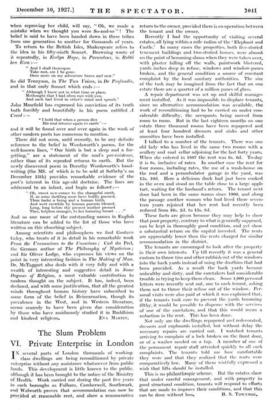The Slum Problem VI. '-Private Enterprise in London
IN several parts . of London thousands of working- class dwellings are being reconditioned by private enterprise without any assistance whatsoever from public funds. This development is little known to the public, although it has been brought to the notice of the Ministry of Health.' Work 'carried out during the past five years in such boroughs as Fulham,_ Camberwell, Southwark, and Walworth proves that accommodation can now be provided at reasonable rent, and show a remunerative return to the owner, provided there is co-operation, between the tenant and the owner.
Recently I had the opportunity of visiting several estates, all lying within a mile radius of the 'Elephant and Castle.' In many cases the properties, both live-storied tenement buildings and two-storied houses, were almost on the point of becoming slums when they were taken over, with plaster falling off the walls, paintwork blistered, yards inches deep in refuse, windows and window-panes broken, and the general condition a source of constant complaint by the local sanitary authorities. The size of the task may be imagined from the fact that on one estate there are a quarter of a million panes of glass.
A repair department was set up and skilful manage- ment installed. As it was impossible to displace tenants, since no alternative accommodation was available, the work of reconditioning had to be carried on under con- siderable difficulty, the occupants being moved from room to room. But in the last eighteen months on one estate three thousand rooms have been repapered and at least four hundred dressers and sinks and other amenities have been installed.
I talked to a number of the tenants. There was one old lady who has lived in the same two rooms with a scullery and coal cellar adjoining for the last forty years. When she entered in 1887 the rent was Os. 6d. To-day it is 8s. inclusive of rates. In another case the rent for four rooms, including rates, the use of a wash-house on the roof and a perambulator garage in the yard, was 15s. 10d. Here a delicious duck had just been cooked in the oven and stood on the table close to a large apple tart, .waiting for the husband's return. The tenant next door had been in the same rooms since 1900, and along the passage another woman who had lived there seven- teen years rejoiced that her rent had recently been reduced from 16s. 20. to 15s. 8d.
These facts are given because they may help to show that poor property, contrary to what is generally supposed, can be kept in thoroughly good condition, and yet show a substantial return on the capital invested. The rents are appreciably lower than the rents charged for similar accommodation in the district.
The tenants are encouraged to look after the property in their own interests. Up till recently it was a general 'custom to throw tins and other rubbish out of the windows into the back yards instead of using the dustbins that had been provided. As a result the back yards became unhealthy and dirty, and the caretakers had considerable 'trouble in trying to keep them clean. Some 4,000 personal letters were recently sent out, one to each tenant, asking them not to throw their refuse out of the window. Per- sonal visits were also paid at which it was explained that, if the tenants took care to prevent the yards becoming filthy, it would be possible to dispense with the services of one of the caretakers, and that this would mean a reduction in the rent. This has been done.
Not only are the dwellings repapered and redecorated, dressers and cupboards installed, but without delay the necessary repairs are carried out. I watched tenants arriving to complain of a lock broken on the front door, or of a wisher needed on a tap. A member of one of the permanent repair staff attended quickly to all such complaints. The tenants told .me how comfortable they were and that they realized that the rents were comparatively low. Many of them wistfully expressed a Wish that lifts should be installed.
• This is no philanthropic scheme. But the estates show that- under- careful management, and with property in good structural condition, tenants will respond to efforts that are made to improve their conditions, and that this can be done without loss. B. S. TOWNROE,










































 Previous page
Previous page